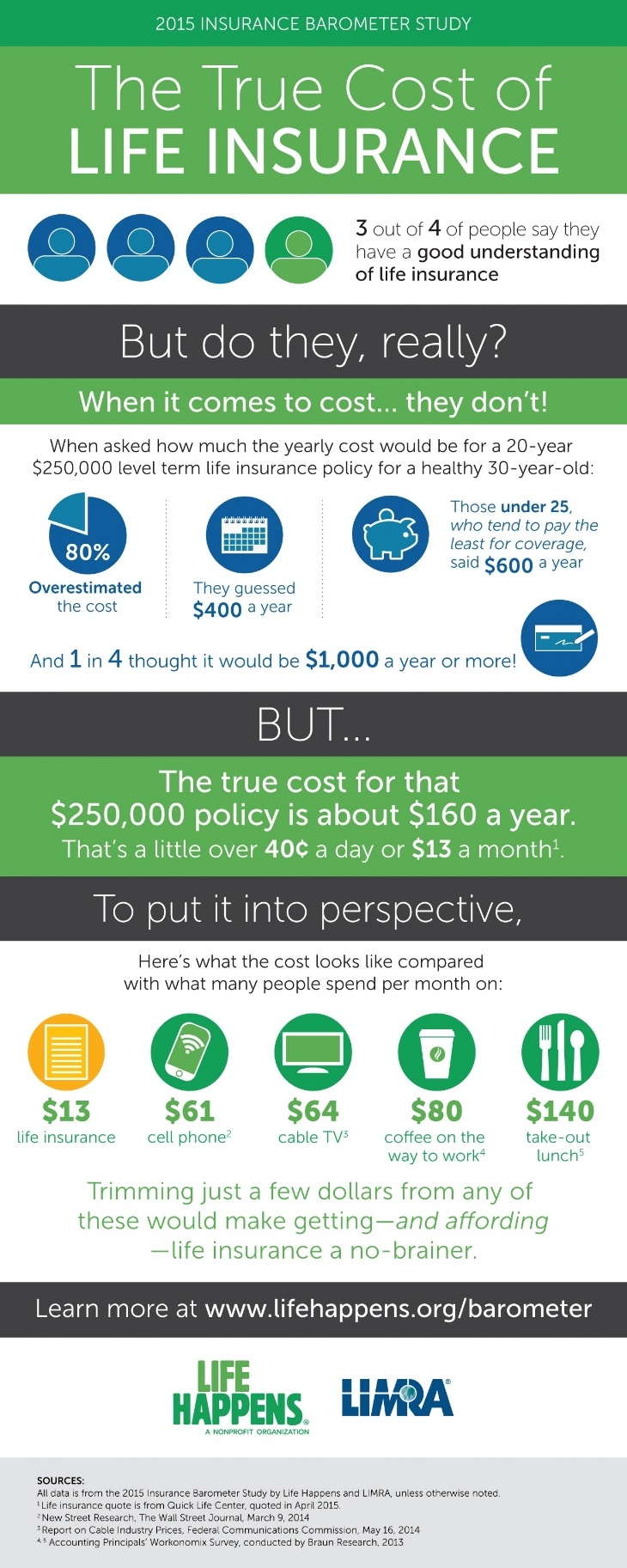Did you know that 6 in 10 American households with children have an average life insurance gap of $320,000?
What’s a life insurance gap?
The technical definition is: the total amount of life insurance needed less the actual amount of life insurance currently in place.
And in 2015, that gap surpassed a whopping $16 trillion in the United States, according to LIMRA.
As we conclude Life Insurance Awareness Month, we’re continuing our mission to educate consumers not only about the importance of life insurance, but to shed some light on one of the most common reasons cited for not purchasing adequate life insurance: the perceived cost.
The fact is, over 80% of consumers overestimated the cost of life insurance with millennials overestimating the cost by 213% and Gen Xers overestimating the cost by 119%.

The 2015 Insurance Barometer Study
The Insurance Barometer Study is a joint project between LIMRA and Life Happens, which analyzes consumer trends and consumers’ perceptions regarding life insurance, retirement and their financial well-being.
Here are the highlights:
- In a list of financial priorities, life insurance comes in 7th with less than 40% of Americans even having a concern about it
- More than 2/3 of Americans are more worried about saving for retirement than dying prematurely… which interestingly enough, a premature death would have serious consequences on retirement savings
- More than 40% of Americans don’t own any amount of life insurance
- Of those who do have life insurance, 1/3 only have coverage through a group plan – typically coverage provided by their employer, which sadly, almost always disappears when they’re no longer employed
- Only 3 in 10 Americans believe they have sufficient life insurance coverage
So if 70% of Americans know they don’t have enough life insurance to protect their loved ones, what’s holding them back?
The number one reason cited is the perceived cost… but we’ve already addressed how drastically the cost is overestimated.
So what’s holding you back?
Real Life Story
Let’s face it, the statistics are great, but unfortunately, they don’t do a great job of demonstrating how a family feels the impact of losing a wage earner prematurely… and all too often, the length of time it takes to get back on their feet is drastically underestimated.
Take for example the Canter family, where Steve had started and built a successful construction business. All was progressing smoothly until one day at a jobsite, Steve’s lungs became contaminated. He spent months in and out of hospitals, trying to get better… but he never fully recovered.
During the time Steve was unable to work, his wife, Melinda, was doing everything possible to keep the business afloat. The good news was, Steve actually had life insurance in place before his lungs became contaminated.
The bad news… Melinda let the policy lapse figuring they’d be able to get coverage at some point in the future when Steve was better, and business returned to normal.
When Steve’s health did not improve, and the business was continuing to suffer, Melinda made the difficult decision to sell their house and many of their assets so the family could move to Florida in an effort to help Steve get better.
The day after moving into their Florida home, Steve’s son, Brandon, had a field trip that he needed his dad to take him on. When Brandon went to wake his dad, he tragically discovered that Steve had passed away in the middle of the night.
Steve was 44 years old.
Losing a father and husband at such a young age is tragedy enough… what followed Steve’s death no family should ever experience.
The financial situation was so difficult for the Canter family that they lost their house in Florida, were evicted from the two subsequent apartments they were in, and ultimately had to split up their family to go live with friends.
Melinda was doing her very best, working multiple jobs, upwards of 80 hours per week, but still struggling to make ends meet.
Thankfully, because of Melinda’s positive attitude and perseverance, she was able to hold her family together despite one tragedy after another that could have easily torn them apart.
And after experiencing such difficulty and heartache, Melinda’s advice: ‘Nobody is promised tomorrow so what you can take care of today to alleviate some of the stress on your family, it definitely behooves everyone to have it.’
Conclusion
Trying to figure out the best way to protect your loved ones with the right type of Life Insurance in Ohio can be confusing, time consuming and difficult.
However, making sure this type of insurance is in place is so incredibly important to ensuring your loved ones don’t suffer financially if you pass away prematurely. Without it, they’re one tragedy away from being in serious financial hardship – just like the Canter’s.
And remember, not all policies are created equal.
You probably wouldn’t go to your eye doctor instead of your dentist if you were having a toothache, right? Just because they’re both doctors doesn’t mean they have the same skillset.
Just the same, you need an Insurance Advisor that understands your individual needs, your business and its goals, and how best to protect them.
We can help.
We know the Life Insurance market, we take the time to listen and understand your needs, and we work with multiple insurance companies so we can deliver the insurance solution that’s perfect for you, and your budget.
When you have confidence in your Insurance Advisor, you have greater peace of mind knowing that your business, your employees, and your family will have the financial resources needed, even when disaster strikes.
To get started on your customized solution, contact one of our Licensed Advisors, or Request a Proposal and we’ll get to work right away.
